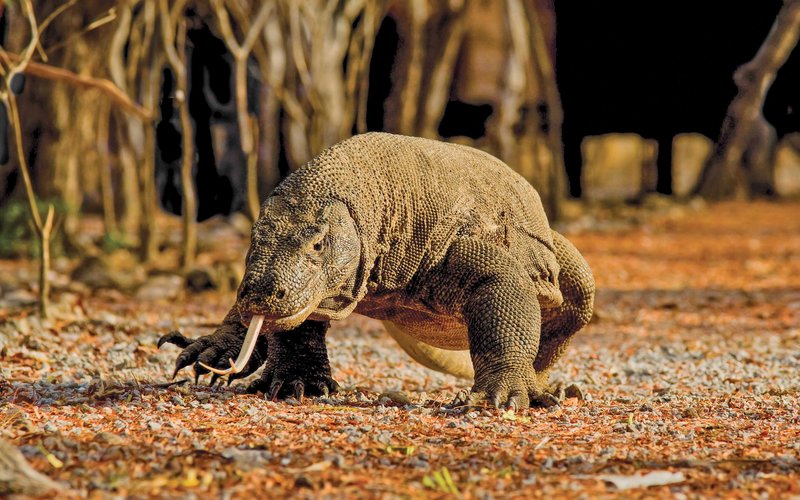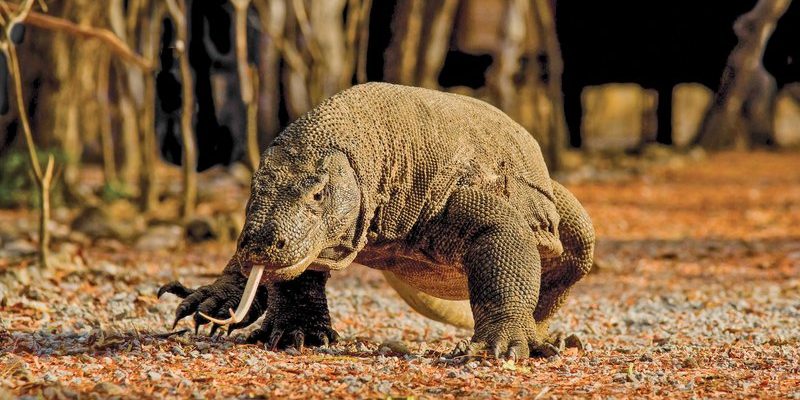
Imagine sipping coffee while watching a fearsome predator in its natural habitat. The Komodo dragon embodies raw power and age-old beauty. But there’s much more to this magnificent creature than meets the eye. Let’s dive into ten amazing facts about the Komodo dragon that’ll make you appreciate it even more.
1. Size and Weight: A Giant Among Lizards
The Komodo dragon is the largest lizard on Earth, reaching lengths of up to 10 feet and weighing around 150 pounds, although some can grow even bigger! To put it into perspective, imagine having a golden retriever as a pet, but then replace it with a lizard that’s about twice as long. When they move, they command attention with their powerful legs and strong tails, which can be used for balance and defense.
These massive reptiles are not just about size; they also have a hulking appearance with strong jaws, sharp claws, and a long, muscular tail. You might be wondering how they manage such weight with agility. Their bodies are built for hunting, allowing them to sprint short distances—perfect for ambushing prey.
2. Habitat: Where Do Komodo Dragons Live?
You might think of dragons as mythical creatures, but the Komodo dragon has a very real and specific home. Found primarily on five Indonesian islands—Komodo, Rinca, Flores, Gili Motang, and Padar—these dragons thrive in dry, tropical savanna environments. This unique habitat offers them the perfect balance of warmth, vegetation, and open space to hunt and bask in the sun.
Living on these islands means that Komodo dragons have adapted to their surroundings over millions of years. With limited resources and a competitive atmosphere, they’ve evolved to become top predators in their ecosystem. They can often be seen lounging around, soaking up the sun, or stealthily stalking their next meal.
3. Diet: What Do Komodo Dragons Eat?
Here’s the thing: Komodo dragons are carnivorous and have a diverse diet. They eat anything from deer and wild boar to smaller birds and even other Komodo dragons! Think of them as nature’s ultimate scavengers. They can consume up to 80% of their body weight in one meal, which is quite impressive.
When hunting, they rely on a combination of stealth and power. Their keen sense of smell helps them track down prey from miles away. Once they’ve located a meal, they can launch themselves incredibly fast, using their razor-sharp teeth to deliver powerful bites. This may sound gruesome, but it’s all part of the natural order.
4. Venom: The Myth and the Reality
A common myth about the Komodo dragon is that they breathe fire or have a venomous bite like in fairy tales. While they don’t breathe fire, there’s an interesting twist: their saliva contains a mix of bacteria that can be harmful to their prey. More recent studies have shown that they do have venom, which can cause shock in their victims.
When a Komodo dragon bites its prey, the bacteria in its mouth introduces toxins into the wound, leading to potential infection and blood loss. This means their prey can suffer for days before succumbing. It’s a brutal but effective hunting strategy that highlights the raw power of these reptiles.
5. Reproduction: The Fascinating Mating Rituals
Komodo dragons have a unique reproductive process that includes some intriguing courtship rituals. During mating season, males often engage in battles to prove their strength and dominance. These fights can look fierce, but they’re actually a way for males to show off their skills without causing real harm.
Once a female selects her mate, she lays around 20 to 30 eggs in a burrow, which she then covers with soil. The eggs incubate for about eight months before hatching, during which time the mother doesn’t provide any care. The hatchlings are left to fend for themselves, showcasing the hard reality of survival in the wild.
6. Lifespan: How Long Do They Live?
In the wild, Komodo dragons can live for about 30 years, but in captivity, they might live even longer—up to 50 years. This is a significant lifespan for reptiles and illustrates their resilience. Imagine a living creature that can witness decades of change in its environment.
Their long lives allow them to maintain their role as top predators, replicating their learned habits and survival tactics over time. You might be surprised to learn that even old dragons can continue to grow, making their already impressive size even more astounding as they age.
7. Conservation Status: Threats to Their Existence
Sadly, the Komodo dragon is classified as a vulnerable species. Habitat loss, climate change, and human encroachment threaten their survival. The population of these magnificent creatures is declining due to deforestation and the impact of tourism, which disrupts their natural habitats.
Conservation efforts are underway to protect these majestic reptiles and their ecosystems. Organizations are working to raise awareness and create protected areas on the islands where they live. Supporting conservation means not only protecting the Komodo dragon but also preserving the beautiful biodiversity of Indonesia.
8. Unique Defense Mechanisms: How They Protect Themselves
Komodo dragons have several strategies when it comes to defense. They can use their size and strength to intimidate potential threats, but they also have another trick up their sleeves: their tough, scaly skin. The skin acts as armor against attacks from other animals.
Additionally, their sharp claws and strong tails serve as effective weapons. If a Komodo dragon feels threatened, it won’t hesitate to use its physical advantages to fight off aggressors. Think about it—what other lizard could stand its ground against a larger predator? It’s fascinating how they can balance being fierce hunters and savvy survivors.
9. Social Structure: Are They Solitary Creatures?
Komodo dragons are primarily solitary animals, meaning they prefer to live alone except during mating season. They establish territories and often engage in occasional confrontations with others over food or space. This social dynamic provides an interesting glimpse into their behavior.
When they’re not competing for dominance, you might find them basking in the sun or resting under the shade of trees. Individual dragons tend to have their unique personalities and habits, making each encounter a new experience. It’s like watching a mini-drama unfold in the wild!
10. Cultural Significance: The Dragon in Folklore
Finally, the Komodo dragon holds cultural significance for the people of Indonesia. Local legends and tales often depict these lizards as unique creatures with mystical powers. They inspire awe and respect, which reflects in the way locals interact with their environment.
In many ways, the Komodo dragon symbolizes the raw beauty and wildness of Indonesia. Its existence draws tourists and researchers alike, creating a cultural link between the dragon and the people. Protecting this majestic lizard is not just an ecological responsibility but also a cultural one for future generations.
As we wrap up our exploration of the Komodo dragon, it’s clear that this extraordinary lizard is deserving of our respect and attention. From its impressive size to its fascinating behaviors, the Komodo dragon continues to captivate those who learn about it. Understanding these creatures requires a blend of curiosity and empathy. After all, they remind us of the wild wonders that exist in our world.

